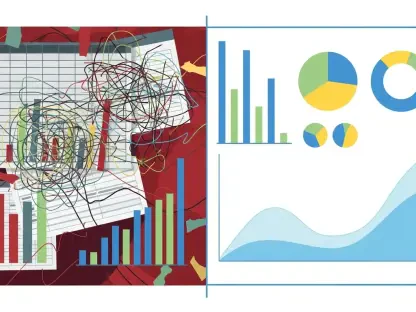In an era where digital landscapes shift at breakneck speed, marketing technology, or MarTech, stands as the cornerstone of innovative strategies that enable brands to forge deeper connections with their audiences. This year, the integration of cutting-edge tools and platforms has redefined how marketers approach campaigns, turning data into actionable insights and transforming customer interactions into personalized experiences. From artificial intelligence to privacy-focused targeting, the advancements in MarTech are not just enhancing efficiency but are fundamentally changing the competitive dynamics of the industry. Businesses that harness these technologies gain a significant edge, achieving higher returns on investment and building stronger customer loyalty. This exploration delves into the most impactful trends shaping the marketing sphere, offering a glimpse into tools and strategies that are driving success across sectors and setting new benchmarks for engagement and performance.
1. Understanding the MarTech Landscape
MarTech encompasses a wide array of software and platforms that marketers leverage to strategize, execute, and evaluate their campaigns with precision. These tools range from Customer Data Platforms (CDPs) that unify consumer information to sophisticated analytics systems that track campaign effectiveness across multiple channels. Social media management tools, marketing automation software, and AI-driven personalization engines also fall under this umbrella, each playing a critical role in streamlining operations. Industry reports indicate that global spending on MarTech is projected to surpass $180 billion this year, reflecting a strong commitment to data-driven approaches. For companies, adopting these technologies is not merely about keeping pace but about unlocking new opportunities to connect with customers in meaningful ways. The ability to harness data effectively ensures that marketing efforts are not wasted, allowing for targeted outreach that resonates with specific audience segments and drives measurable outcomes.
The significance of MarTech extends beyond individual tools to the broader ecosystem of integrated solutions that enable seamless workflows. By connecting disparate systems, marketers can gain a holistic view of their operations, from lead generation to conversion tracking. This integration is vital for eliminating silos within organizations, ensuring that data flows freely between departments and informs decision-making at every level. Furthermore, the scalability of modern MarTech solutions means that businesses of all sizes can benefit, whether they are small startups or global enterprises. As competition intensifies, the ability to adapt quickly using real-time insights becomes a differentiating factor. Companies that prioritize a robust MarTech stack are better positioned to anticipate market shifts, respond to consumer needs, and optimize their budgets for maximum impact, setting a foundation for sustained growth in a crowded digital marketplace.
2. AI-Powered Personalization Leading the Charge
Artificial intelligence has emerged as a game-changer in delivering hyper-personalized experiences that captivate consumers and boost engagement. By analyzing vast amounts of data in real time, AI algorithms can tailor content, product recommendations, and messaging to individual preferences with uncanny accuracy. Think of e-commerce platforms suggesting items based on past purchases or browsing behavior—such personalization mirrors the curated experiences seen on streaming services. The result is a significant uptick in conversion rates, as customers feel understood and valued through interactions that speak directly to their needs. Retention rates also improve, as personalized touchpoints foster a sense of loyalty that generic marketing cannot achieve. For marketers, this technology reduces guesswork, ensuring that every campaign element is optimized for relevance and impact, ultimately driving better business outcomes.
Beyond basic recommendations, AI personalization extends into dynamic content creation and adaptive user journeys that evolve based on real-time feedback. Email campaigns, for instance, can adjust their tone, timing, and offers based on how recipients interact with previous messages, maximizing the likelihood of a response. This level of customization was once unthinkable at scale, but advancements in machine learning have made it a reality for brands across industries. Additionally, AI tools can segment audiences with precision, identifying micro-trends within broader demographics to refine targeting strategies. The financial benefits are clear, with reduced customer acquisition costs and higher lifetime value per user. As privacy concerns grow, AI also offers ways to personalize without overstepping boundaries, using anonymized data patterns to maintain trust while still delivering tailored experiences that resonate deeply with consumers.
3. Predictive Analytics Optimizing Campaign Performance
Predictive analytics has become a cornerstone for marketers aiming to allocate resources with pinpoint accuracy and foresight. By leveraging historical data and machine learning models, this technology forecasts campaign outcomes, identifying which channels and tactics are likely to yield the best results before budgets are spent. This proactive approach allows for strategic adjustments, ensuring that funds are directed toward high-performing initiatives while minimizing waste. Studies suggest that brands using predictive tools can reduce ineffective ad spend by up to 30%, a substantial saving in competitive markets. The ability to anticipate customer behavior also means campaigns can be timed and tailored for maximum relevance, hitting the right audience at the right moment with messages that convert effectively and efficiently.
The applications of predictive analytics go beyond budget optimization to encompass broader campaign planning and risk management. Marketers can simulate various scenarios to understand potential pitfalls or opportunities, adjusting creative elements or targeting parameters accordingly. This data-driven foresight is particularly valuable in fast-moving sectors where trends shift rapidly, allowing brands to stay ahead of the curve. Moreover, integration with other MarTech tools ensures that insights from predictive models feed directly into automation systems, creating a feedback loop that continuously refines performance. For businesses, this translates into not just cost savings but also enhanced decision-making confidence. As data volumes grow, the precision of these tools will only improve, offering even deeper insights into consumer patterns and enabling marketers to craft campaigns that are both impactful and resource-efficient.
4. Embracing Cookieless Targeting Solutions
With the phasing out of third-party cookies, marketers are pivoting toward innovative, privacy-compliant targeting methods that respect consumer boundaries while maintaining effectiveness. First-party data, collected directly from customer interactions through surveys, gated content, or loyalty programs, has become a goldmine for building detailed audience profiles without infringing on privacy. Contextual advertising also plays a pivotal role, placing ads based on the content of a webpage rather than user tracking, ensuring relevance without invasive data practices. These solutions align with growing regulatory demands and consumer expectations for transparency, allowing brands to maintain trust while still reaching their intended audiences. The shift represents a fundamental rethinking of digital advertising, prioritizing ethical data use over outdated methods.
Implementing cookieless strategies requires a robust framework for data collection and analysis, ensuring that first-party insights are both comprehensive and actionable. Brands must invest in technologies that facilitate seamless integration of this data into existing MarTech stacks, enabling personalized campaigns without relying on external cookies. Additionally, partnerships with publishers and platforms that prioritize contextual solutions can amplify reach while adhering to privacy standards. The transition is not without challenges—building a sufficient volume of first-party data takes time and strategic planning—but the long-term benefits include stronger customer relationships and resilience against future regulatory changes. As the digital ecosystem evolves, those who adapt to these cookieless approaches will find themselves better equipped to navigate a landscape where consumer trust is as valuable as conversion rates.
5. Charting the Path Forward with MarTech Innovations
Reflecting on the strides made, it is evident that MarTech has become an indispensable ally for marketers aiming to thrive in a dynamic environment. The adoption of AI-driven personalization has reshaped how brands connect with individuals, while predictive analytics has refined the art of resource allocation with remarkable precision. Cookieless targeting has addressed pressing privacy concerns, proving that effectiveness and ethics can coexist in digital advertising. These advancements have laid a solid groundwork for businesses to enhance customer experiences and achieve measurable growth over time. Looking ahead, the focus should shift to continuous adaptation, ensuring that teams are trained to leverage emerging tools effectively. Investing in scalable platforms that integrate seamlessly across channels will be crucial for maintaining agility. Additionally, staying abreast of regulatory shifts and consumer expectations will safeguard trust and relevance. By prioritizing these steps, brands can harness MarTech not just as a tool, but as a catalyst for sustained innovation and competitive advantage in the evolving marketing landscape.









